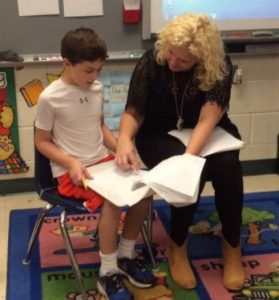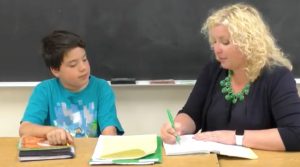This post is written by member Patty McGee.
A few questions for you:
- Have you noticed that when you correct writing, students often pay little attention to those corrections and their writing does not seem to evolve from those corrections?
- Do your students seem to approach writing as a task to complete rather than an expression of their voice and ideas?
- Are your students quick finishers and reluctant to revise their writing?
If the answer is yes to any of these questions, you may want to employ this trio of teaching moves so writers grow in the light of your feedback.
 1. Be a Mentor Writer
1. Be a Mentor Writer
A mentor writer is one who:
- gives feedback (outside of grades) throughout the process of writing, not just at the end
- shares his or her struggles in writing with other writers and ways to work through these struggles
- brings a tone of support, understanding, and passion for writing
- sits side by side with writers and names strengths and the next step
Teachers who have made this switch have found profound changes in their writers both immediately and over time.
When writers are mentored, they are more likely to take risks, ask for feedback, and make writerly choices.
Because writers expect not to be judged (or graded), the writing flows and struggle is normalized.
A few tips on being a mentor writer:
- If you are in a classroom that must give grades, let the writers know that you will be taking the grading hat off and putting on your mentor hat. Explain to them the difference and what to expect from you.
- Ask writers what they would like feedback on and give feedback on only those parts. It is not necessary to mentor a writer’s entire piece in one meeting.
- Bring a notebook and pen to model writing strategies in your own writing.
This last tip brings us to the other two instructional moves to complete the trifecta: strategies and modeling.
2. Teach Strategies (with Soul)
Knowing writing strategies is a great challenge for many students. They may know that they need to elaborate (which is a skill), but how to elaborate is the challenge. By definition, a strategy is a how-to, a way to access a skill. Where can you find these strategies? The most meaningful strategies are found within your head and heart. This is teaching strategy with soul. Here’s how it might go.
- Notice the skill the writer is ready for or has asked to learn.
- Think to yourself, “If I were the writer of this piece, with the skills that this writer has, what would I do?”
- Then share that step-by-step with the student.
Let’s try it with this sample:

This writer looked at this page in her informational book on soccer and wanted to add detail. I asked myself, with what I can see this writer can already do, what can be her next step? While there are many possibilities, let’s say she’s ready to add boldfaced words with definitions. A strategy could be:
Writers of informational text often add important words and their definitions. Here’s one way:
- Take a look at your diagram and find the keywords a reader should know.
- Write them in bold.
- Write a definition or description next to the bolded word.
While this may be enough for some kids, the final, knock-writing-instruction-out-of-the-park move is to add a model.
 3. Model
3. Model
As a mentor writer who shares writing strategies, you may find that writers often need to see the strategy in action. We naturally do this all the time—I certainly do! When trying a new dish, I am more likely to choose the recipe that has a video paired with it. My mentor and friend Gravity Goldberg compares the modeling we do in the classroom to that of a cooking show host. Cooking show hosts:
- Show a step-by-step
- Have ingredients ready
- Offer advice on the tricky parts
- Narrate the strategy as they model
- Don’t ask questions (How much ground beef should I use for this meatloaf?)
To model this strategy, you might use a separate piece of paper and say, “Watch me as I . . .” and then model step-by-step, going from the diagram, picking out a keyword, bolding it, and writing a definition. For you to model strategy as a mentor writer, you simply need pencil and paper to show and advice to add.
I invite you to build this into your writing classrooms. Take off the correcting hat and be the mentor writer who models strategies. I know you will experience what so many other teachers have—joyful, connected writing instruction and writers who grow exponentially.
Patty McGee is a literacy consultant whose passion and vision is to create learning environments in which teachers and students discover their true potential and power. She is the author of Feedback That Moves Writers Forward: How to Escape Correcting Mode to Transform Student Writing (Corwin 2017). Patty’s favorite moments are when groups of teachers are working with students collaboratively in the classroom. She tweets at @pmgmcgee.

